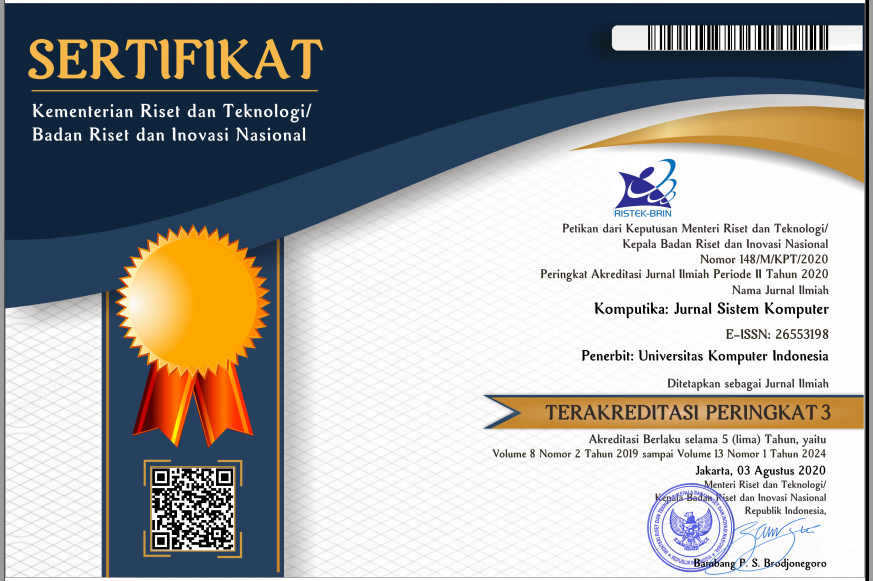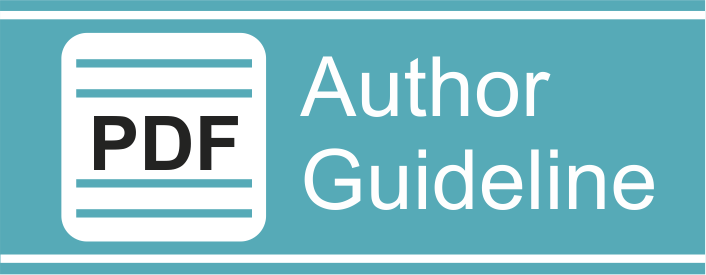Klasifikasi Kematangan Pisang Menggunakan Metode Convolutional Neural Network
DOI:
https://doi.org/10.34010/komputika.v12i2.9999Abstract
ABSTRACT – Bananas are plants from the Southeast Asian region and belong to the genus Musa and the family Musaceae. Grown in tropical and subtropical regions, bananas are one of the agricultural commodities with the largest production compared to other fruits. Indonesia is one of the countries that produce the largest bananas in the world. The yields are then sorted based on the level of ripeness by looking at the color change of the banana skin. However, the process of sorting bananas requires a lot of time and effort due to the large production of bananas. In addition, differences in the assessment of each individual on changes in the color of banana peels result in an unstable or consistent sorting of bananas. Therefore, this study intends to create a ripeness classification system for bananas based on changes in skin color with the aim that the sorting process can be carried out efficiently and accurately. The color variants used range from dominant green for unripe bananas, dominant yellow for ripe bananas and blackish brown spots for overripe bananas. The method used is a Convolutional Neural Network with a self-designed architecture. The results showed that the accuracy reached 88% with a learning rate setting of 0.001 and a maximum epoch limit of 15.
Keywords – Classification; Banana Fruit; Convolutional Neural Network; Deep Learning; Computer Vision
References
“Terus Dorong Peningkatan Konsumsi Buah Nusantara, Pemerintah Gelar Kembali Gelar Buah Nusantara (GBN) ke-7 Tahun 2022 – Kementerian Koordinator Bidang Perekonomian Republik Indonesia.” https://www.ekon.go.id/publikasi/detail/4450/terus-dorong-peningkatan-konsumsi-buah-nusantara-pemerintah-gelar-kembali-gelar-buah-nusantara-gbn-ke-7-tahun-2022 (diakses 15 Juni 2023).
S. A. Damayanti, A. Arkadia, dan D. S. Pravista, “Klasifikasi Buah Mangga Badami Untuk Menentukan Tingkat Kematangan dengan Metode CNN,” Prosiding Seminar Nasional Mahasiswa Ilmu Komputer dan Aplikasinya, vol. 2, no. 2, hlm. 158–165, 2021.
F. Paraijun, R. N. Aziza dan D. Kuswardani, “Implementasi Algoritma Convolutional Neural Network Dalam Mengklasifikasi Kesegaran Buah Berdasarkan Citra Buah,” KILAT, vol. 11, no. 1, hlm. 1-9, 2022.
Y. B. E. Purba, N. F. Saragih, S. Sitepu dan A. Gea, “Implementasi Algoritma Convolutional Neural Network Dalam Mengklasifikasi Kesegaran Buah Nanas Dengan Menggunakan Mikrokontroler Dengan Metode Convolutional Neural Network (CNN),” Jurnal Ilmiah Teknik Informatika METHOTIKA, vol. 2, no. 1, hlm. 13-21, 2022.
B. Yanto, L. Firmawahib, A. Supriyanto, B. H. Hayadi dan R. R. Pratama, “Klasifikasi Tekstur Kematangan Buah Jeruk Manis Berdasarkan Tingkat Kecerahan Waran dengan Metode Deep Learning Convolutional Neural Network,” INOVTEK Polberg-Seri Informatika, vol. 6, no. 2, hlm. 259-268, 2021.
S. Mala dan Rasiban, “Klasifikasi Kematangan Buah Pisang Tanduk Berdasarkan Warna Menggunakan Metode Hue Saturation Value (HSV),” JUPITER (Jurnal Penelitian Ilmu dan Teknik Komputer), vol. 1, no. 1, hlm. 197-207, 2022.
S. Khan, H. Rahmani, S. A. A. Shah, dan M. Bennamoun, A Guide to Convolutional Neural Networks for Computer Vision. dalam Synthesis Lectures on Computer Vision. Cham: Springer International Publishing, 2018. doi: 10.1007/978-3-031-01821-3.
A. Asrafil, A. Paliwang, M. R. D. Septian, M. Cahyanti dan R. Swedia, “Klasifikasi Penyakit Tanaman Apel Dari Citra Daun Dengan Convolutional Neural Network,” SEBATIK, vol. 24, no. 2, hlm. 207–212, 2020.
Y. Rizki., R. M. Taufiq, H. Mukhtar dan D. Putri, "Klasifikasi Pola Kain Tenun Melayu Menggunakan Faster R-CNN," IT Journal Research and Development, vol. 5, no. 2, hlm. 215 - 225, 2021.
A. Ramdan, V. Zilvan, E. Suryawati, H. F. Pardede dan V. P. Rahadi, “Tea Clone Classification Using Deep CNN with Residual and Densely Connections,” Jurnal Teknologi dan Sistem Komputer, vol. 8, no. 4, hlm. 289–296, 2020.
M. B. Bejiga, A. Zeggada, A. Nouffidj, dan F. Melgani, “A Convolutional Neural Network Approach for Assisting Avalanche Search and Rescue Operations with UAV Imagery,” Remote Sensing, vol. 9, no. 2, hlm. 100, Feb 2017, doi: 10.3390/rs9020100.
A. Rosebrock, Deep learning for computer vision with python: Starter bundle, 1 ed. PyImageSearch, 2017.
M. L. Prasetyo dkk., “Face recognition using the convolutional neural network for Barrier Gate System,” iJIM: International Journal of Interactive Mobile Technologies, vol. 15, no. 10, hlm. 138–153, 2021.
H. Abhirawa, J. Jondri, dan A. Arifianto, “Pengenalan Wajah Menggunakan Convolutional Neural Network,” eProceedings of Engineering, vol. 4, no. 3, hlm. 4907-4916, 2017.
A. Kurniadi, “Implementasi Convolutional Neural Network Untuk Klasifikasi Varietas Pada Citra Daun Sawi Menggunakan Keras,” Doubleclick, vol. 4, no. 1, hlm. 25, Agu 2020, doi: 10.25273/doubleclick.v4i1.5812.



















